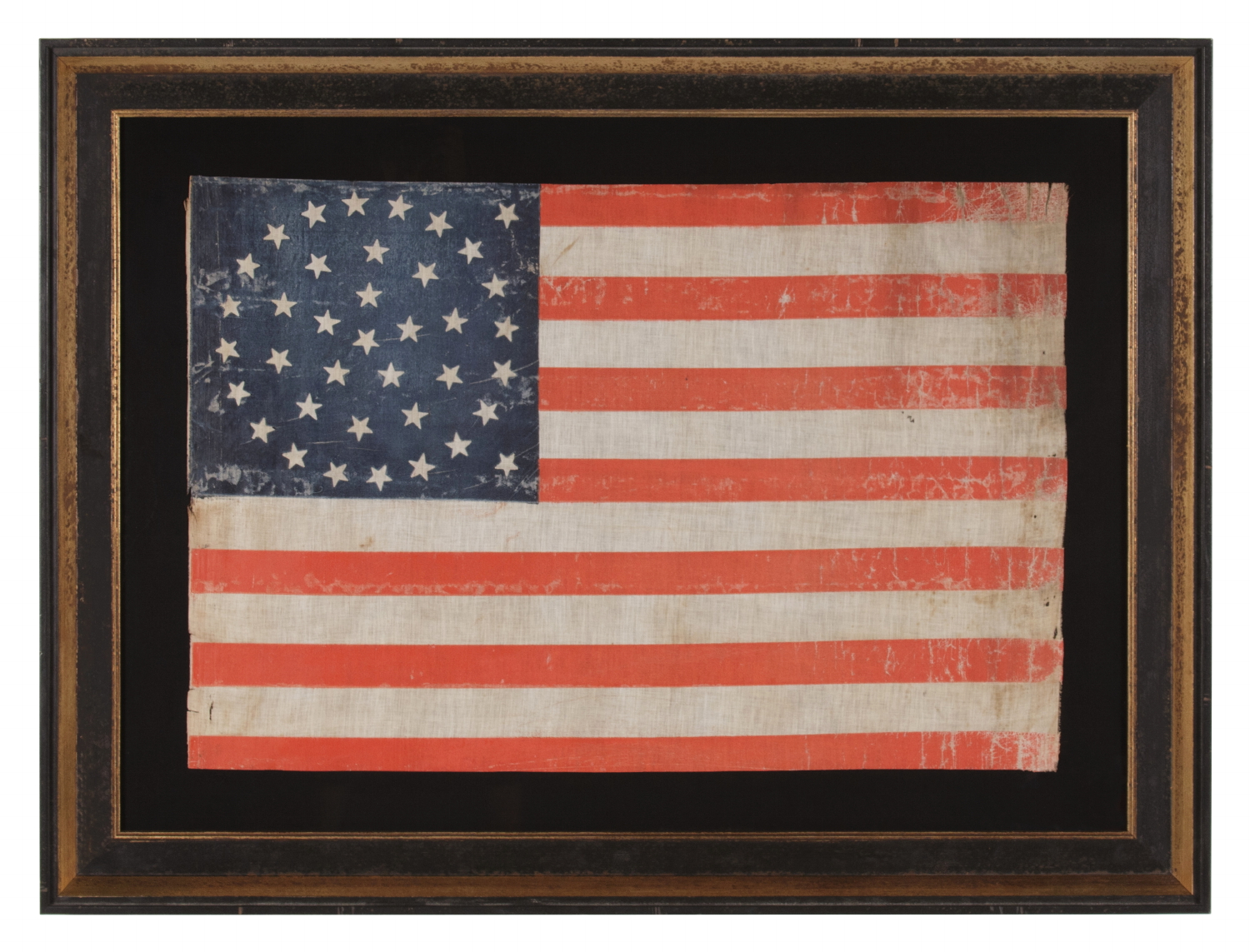
| |
38 STARS IN A BEAUTIFUL MEDALLION CONFIGURATION WITH 2 OUTLIERS, ON A LARGE SCALE ANTIQUE AMERICAN PARADE FLAG OF THE 1876-1889 ERA, COLORADO STATEHOOD |
|
| Available: |
Sold |
| Frame Size (H x L): |
35.25" x 47" |
| Flag Size (H x L): |
24" x 35.5" |
|
| Description....: |
|
38 star American parade flag, block-printed by hand on coarse, glazed cotton. The stars are arranged in a triple-wreath form of the medallion configuration, with a single center star and two stars flanking outside the basic pattern toward the fly end. Typically there are 4 flanking stars outside this type of pattern, one in each corner. The inclusion of only two was done intentionally to leave room for the easy addition of two more states. Flag-makers felt that more Western Territories were soon to be added to the Union and eagerly anticipated their arrival.
Colorado became the 38th state on August 1st, 1876. This was the year of our nation’s 100-year anniversary of independence. Per the Third Flag Act of 1818, stars were not officially added until the 4th of July following a state's addition. For this reason, 37 was the official star count for the American flag in 1876. Flag-making was a competitive venture, however, and few flag-makers would have been continuing to produce 37 star flags when their competitors were making 38’s. It is for this reason that 38 and 13 stars (to represent the original 13 colonies) are more often seen at the Centennial International Exposition, the six-month long World’s Fair held in Philadelphia in honor of the event. Some flag-makers would have been adding a star for the 38th state even before it entered the Union, in the early part of 1876 or even prior. In fact, many makers of parade flags were actually producing 39 star flags, in hopeful anticipation of the addition of two more Western Territories instead of one. But the 39th state would not join the Union for another 13 years, when the Dakota Territory entered as two states on the same day. The 38 star flag became official on July 4th, 1877 and was generally used until the addition of the Dakotas in 1889.
Also known as hand-wavers, most parade flags measured three feet long or less. Larger examples, such as this one, make a bold statement, especially those with dynamic star patterns.
President Ulysses S. Grant was in office when the first 38 star flags would have appeared. The list of presidents serving during the period when the 38 star flag was actually official include Rutherford B. Hayes, James Garfield, Chester Arthur, Grover Cleveland, and Benjamin Harrison.
Mounting: The flag was mounted and framed within our own conservation department, which is led by masters degree trained staff. We take great care in the mounting and preservation of flags and have framed thousands of examples; more than anyone worldwide.
The black-painted, hand-gilded and distressed molding is Italian. The glazing is U.V. protective acrylic. Feel free to contact us for more details.
Condition: There is modest pigment loss in the canton and there is modest wear and soiling at the fly end with moderate pigment loss. There is minor pigment loss and soiling elsewhere. There is some fabric breakdown along the hoist end, where the flag was once attached to its original wooden staff, and there is a vertical tear near the hoist end in the last white stripe. Many of my clients prefer early flags to show their age and history of use. |
|
|
|
| Collector Level: |
Intermediate-Level Collectors and Special Gifts |
|
| Flag Type: |
Parade flag |
|
| Star Count: |
38 |
|
| Earliest Date of Origin: |
1876 |
|
| Latest Date of Origin: |
1889 |
|
| State/Affiliation: |
Colorado |
|
| War Association: |
1866-1890 Indian Wars |
|
| Price: |
SOLD |
|
| |
Views: 1498 |
|
|
|

